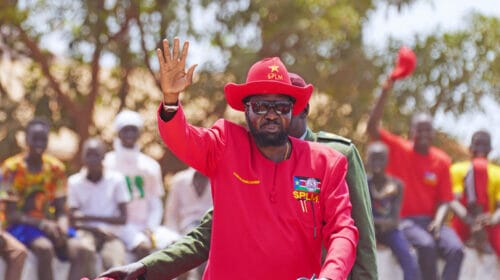Families flee from South Sudan to Uganda in Africa’s biggest exodus since 1994 Rwandan genocide
At least 832,000 South Sudanese refugees have arrived in Uganda since fighting erupted in July last year, in the biggest cross-border exodus in Africa since the 1994 Rwandan genocide. Overall, the fighting has uprooted more than three million people, and by July 5.5 million – nearly half the population – are unlikely to have a reliable food supply, according to the United Nations.
The influx of refugees is testing the generosity of Ugandans, many of whom, including President Yoweri Museveni, were once refugees themselves. One top government official said that Uganda’s system of accommodating refugees, routinely touted as one of the world’s most progressive, was on the brink of “explosive” collapse.
The South Sudanese Civil War is a conflict in South Sudan between forces of the government and opposition forces.
In December 2013, President Kiir accused his former deputy Riek Machar and ten others of attempting a coup d’état. Machar denied trying to start a coup and fled to lead the SPLM – in opposition (SPLM-IO).Fighting broke out between the SPLM and SPLM-IO, igniting the civil war. Ugandan troops were deployed to fight alongside South Sudanese government.[50] The United Nations has peacekeepers in the country as part of the United Nations Mission in South Sudan (UNMISS). In January 2014 the first ceasefire agreement was reached. Fighting continued and would be followed by several more ceasefire agreements. Negotiations were mediated by “IGAD +” (which includes the eight regional nations called the Intergovernmental Authority on Development as well as the African Union, United Nations, China, the EU, USA, UK and Norway). A peace agreement known as the “Compromise Peace Agreement” was signed in August 2015. Machar returned to Juba in 2016 and was appointed vice president. Following a second breakout of fighting within Juba, the SPLM-IO fled to the surrounding and previously peaceful Equatoria region. Machar was replaced by Kiir as First Vice President by Taban Deng Gai, splitting the opposition, and rebel in-fighting has become of major part of the fighting
In December 2013, President Kiir accused his former deputy Riek Machar and ten others of attempting a coup d’état. Machar denied trying to start a coup and fled to lead the SPLM – in opposition (SPLM-IO).Fighting broke out between the SPLM and SPLM-IO, igniting the civil war. Ugandan troops were deployed to fight alongside South Sudanese government.[50] The United Nations has peacekeepers in the country as part of the United Nations Mission in South Sudan (UNMISS). In January 2014 the first ceasefire agreement was reached. Fighting continued and would be followed by several more ceasefire agreements. Negotiations were mediated by “IGAD +” (which includes the eight regional nations called the Intergovernmental Authority on Development as well as the African Union, United Nations, China, the EU, USA, UK and Norway). A peace agreement known as the “Compromise Peace Agreement” was signed in August 2015. Machar returned to Juba in 2016 and was appointed vice president. Following a second breakout of fighting within Juba, the SPLM-IO fled to the surrounding and previously peaceful Equatoria region. Machar was replaced by Kiir as First Vice President by Taban Deng Gai, splitting the opposition, and rebel in-fighting has become of major part of the fighting

The Rwandan genocide, also known as the genocide against the Tutsi, was a genocidal mass slaughter of Tutsi in Rwanda by members of the Hutu majority government. An estimated more than 800,000 Rwandans were killed during the 100-day period from April 7 to mid-July 1994, constituting as many as 70% to 80% of the Tutsi population. Additionally, 30% of the Pygmy Batwa were killed. The genocide and widespread slaughter of Rwandans ended when the Tutsi-backed and heavily armed Rwandan Patriotic Front (RPF) led by Paul Kagame took control of the country. An estimated 2,000,000 Rwandans, mostly Hutus, were displaced and became refugees.
The genocide was planned by members of the core political elite, many of whom occupied positions at top levels of the national government. Perpetrators came from the ranks of the Rwandan army, the Gendarmerie, government-backed militias including the Interahamwe and Impuzamugambi.




